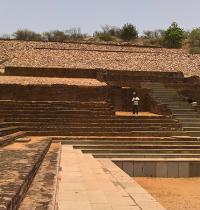Umashankar Manthravadi
Grant Period: over one year
Umashankar Manthravadi is a very senior and rare sound artist in India. He is considered a genius for his work with sound recording and archiving. An enthusiast in electronics, he has over the past four decades been credited with many inventions in sound technology. Some of these are now in popular use in the industry but he was the pioneer creating them on shoestring budgets. He was also instrumental in setting up and maintaining the Archives and Research Center for Ethnomusicology (part of the American Institute of Indian Studies), Gurgaon over the years. His last invention has been an ambisonic tetrahedral microphone system called Brahma. This project is going to be the test of his invention in archaeoacoustics. He will collaborate with Nida Ghouse, a curator and ex-IFA grantee and Lawrence Abu Hamdan, a sound artist from Lebanon for this project which is seen as a pilot for a much larger initiative in sound in the country. He might also take help of other artists in the process. (It is important to note that the grant funds will not pay for any foreign artists.)
Archaeoacoustics - the study of acoustic properties of an archaeological site or object - is a new concept in archaeology with serious work starting to appear across the world only in the current millennia. Archaeology as a discipline has over the years been mostly dependent on the visual and the chemical. While sites are studied mostly in terms of their visual architecture with the effects of geological and natural forces also taken into account, historical objects are studied for their chemical composition to determine their vintage with visual clues accounting for their craftsmanship. Unless an object distinctly stands out as a musical instrument its acoustic properties has hardly been discussed.
However, with the advent of digital technology it is now possible to measure, record and reproduce the acoustic properties of a site. This process, called ambisonics, is a mathematically accurate way of recording sound in two or more dimensions. The recreation of sonic environments is today used by many modern sound designers. It has become so common that all digital audio devices now come with a bunch of equalizer settings that can change the dimensions of any recorded sound to simulate the features of specific listening environments (corridor, parking lot, gallery, lounge etc.).
Limited knowledge in acoustics of historic and archaeological sites has led to a dangerous tendency. Whenever such a site goes under restoration, only visual conservation is undertaken which preserves the buildings from decay but hampers their acoustic properties. As a result over the years it has become quite impossible to study the sonic legacies of these sites. In India this is a unique problem since many historic and archaeological sites ranging from temples to palaces were originally built with performances built in to their utility with distinct acoustic properties. In absence of microphones, architecture was solely responsible for the acoustics of these spaces and many such sites even today bear the signs of these architectural marvels. However, there have been no studies to understand and unearth the experiences of listening at these sites. This project is an unique attempt in India to map some of these sites for their acoustic properties. Using ambisonic processes to measure impulse responses this project is attempting to bring in a paradigmatic shift in the understanding of history. Once perfected, this method will enable us to experience the performance of sound at these sites, thus creating a template for the history of listening. Even in terms of archaeoacoustics this is a pioneering step. The project attempts to distinguish between ‘measuring’ and ‘recording’. So far whatever little documentation has taken place has been done in textual form using scientific jargons thus being accessible to a miniscule group of sonic experts. Also, the impulse measurement of ambisonic process has not been tried widely because of the prohibitive costs and logistics. However, with the help of Umashankar’s inventions it will now be possible to literally ‘transport’ one acoustic space to another - recreate those sonic spaces on a web platform and can be experienced by users through headphones. Umashankar wants to create an archive of such ambisonic recordings on a web platform, which when made public will enable the user to access many archaeological acoustic environments, download the parameters and apply any recorded sound to study these listening experiences.
While Umashankar has seven such sites in mind for his larger initiative across India, the work at the first two - Nagarjunakonda in Andhra Pradesh and Guruvayoor Temple, Kerala - will be supported by IFA as a pilot project under this grant. The entire process will be filmed and the outcome that this stage for this grant will be this film. The web platform for listening experiences and an audio installation in an exhibition context accompanied by a series of lecture-demonstrations are hoped for at the end of the larger initiative. It is important to note here that while IFA is now supporting only a pilot, given the scope of the project, its criticality in the field, its pioneer position, and the expertise of the people involved, this might be a long term project for IFA to support its later phases and see it through to its ultimate goals and outcomes. What makes this project even more special is the idea of engaging large publics through the website to actually experience the listening at archaeological sites thus bringing them alive.
This grant was made possible with support from Titan Company Limited.

